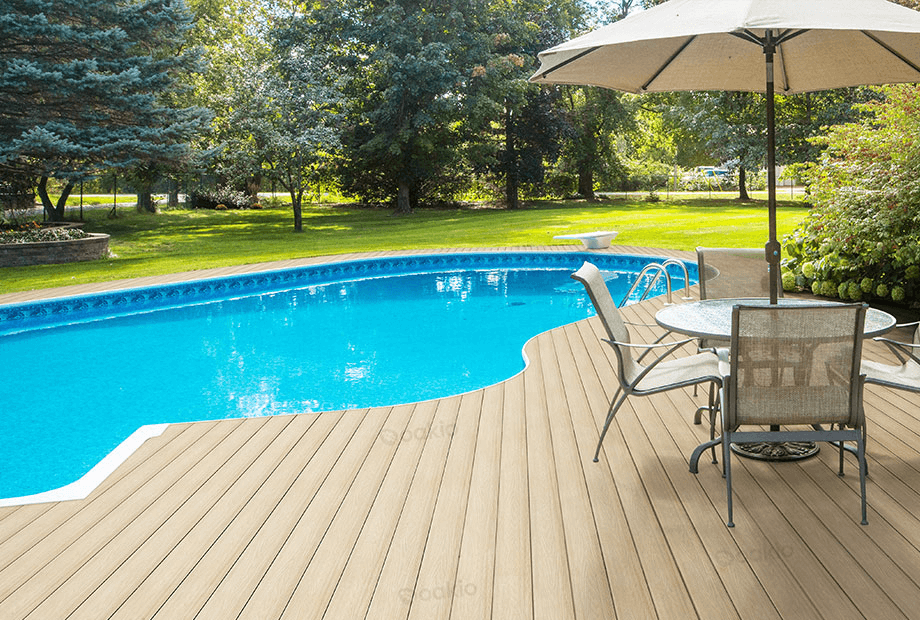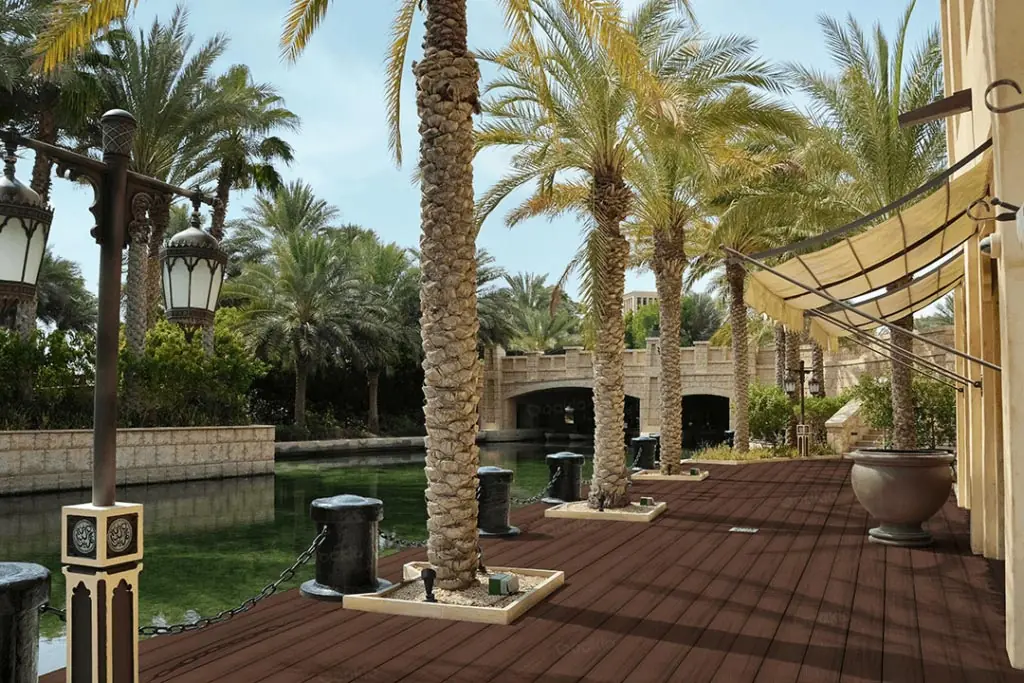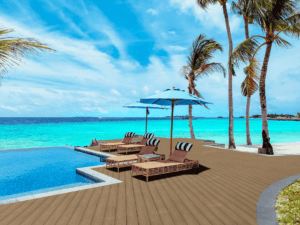Why Do You Want a Waterproof Deck?
A deck beside a pool or a beachfront house can be a relaxing and stunning place to eat, relax, and just enjoy the company of other people—a picture-perfect scene in your outdoor space. But there’s a problem: water damage.
So, why do you want a waterproof deck? Constant water exposure can deteriorate your deck over time, leading to warping, rotting, and the growth of mold and mildew, which can compromise your family’s safety.
What’s even more upsetting is that your invested money could go to waste if your deck remains unprotected from damaging water penetration. Thankfully, a waterproof deck can address these concerns.
How Water Damage Happens

Water damage is a common issue among traditional decking materials, like untreated wood. Water damage starts when the material starts to absorb water over a prolonged period, leading to warping, splitting, or rotting.
The problem is that even traditionally waterproofed materials using sealants and stains only offer a certain degree of protection and are guaranteed to last only a few years. Traditional deck waterproofing requires regular maintenance to work long-term.
Here are other factors to take note of with regards to water penetration and subsequent damage:
Freshwater Exposure vs. Saltwater
Freshwater is damaging to decks and can cause swelling, rotting, or warping over time. But the real headache occurs when your deck is near a body of saltwater as it poses another problem that can compromise the structural integrity of your deck.
Saltwater is known to cause rust and corrosion to metal fasteners, screws, and other related hardware—which poses a safety risk to your deck in the long run.
High Humidity & Tropical Areas
Areas with high humidity, such as tropical areas often face a constant threat of moisture damage. Though not directly causing severe water penetration, the unhealthy levels of moisture in the air can still be absorbed by the material—causing warping, rotting, and mold growth faster compared to dry areas.
High Precipitation Areas
If you live in a region where it rains almost every day of the year, your deck is in for a rough ride. Rainfall and snow can pose a risk of faster deterioration to your deck as water can seep and penetrate even to the smallest seams or cracks, paving the way for mold and rotting to occur.
Mold, Fungi, and Rotting
If your deck absorbs moisture from humid air, snow, rain, freshwater, or saltwater, you can almost guess a hundred percent that mold, mildew, and rotting can occur soon. Since mold and mildew feed on moisture and wood fibers, they can weaken the deck structure over time.
The Signs and Risks of Water Damage
Every water damage has early signs and symptoms, most of which are subtle and hard to spot. In order to prevent significant damage to your deck, it pays to know what are the slightest signs and symptoms of water damage so you can act fast.
Early Signs & Minor Water Damage
The first signs of water damage in a deck can be as slight as a small discoloration in one deck board, or a single spot that seems to fade. The wood may be soft to the touch and you may start to notice tiny cracks on the surface.
If these signs are left alone, they can deteriorate fast if the source of moisture is not stopped.
Moderate Water Damage
When the source of moisture is not identified, unsettling and more noticeable signs will start to appear. If boards start to warp and seemingly bend out of shape, you may already be dealing with a structural issue that needs immediate corrective action.
A moderately damaged deck may show signs of mold growth through black, white, or green spots, and metal hardware may show significant rust and corrosion.
Severe Water Damage
If the source of moisture is not identified ASAP, you can spot severe damage when large sections of the deck start to rot and feel soft to walk on. Sometimes, some sections can sink, making it unsafe to use.
If you see these signs, we suggest cordoning off the entire deck to limit usage, prevent any accidents, and pave the way for temporary retrofitting until a long-term repair solution can be made.
It’s important to prioritize repairs ASAP, if not done so, homeowners can face significant safety risks. Aside from the risks of falling when boards break under weight, severe mold growth can cause respiratory risks.
The Benefits of Waterproof Decks
Waterproof decking provides a myriad of advantages, most of which are particularly helpful when you live in high-risk areas, such as humid, high precipitation, or seaside, riverside, or poolside locations.
Unlike traditional wood decking that absorbs moisture generously, a waterproof deck can resist and withstand water better, leading to a better lifespan and cheaper maintenance costs. Let’s discuss other benefits of waterproof decks:
Safety in Humid and High Precipitation Areas
Waterproof decks offer structural safety in areas with high humidity and precipitation. By resisting constant moisture, you can rest assured your deck will be safe and sound for years to come without needing any major repairs.
Protection from Fungus and Mold
One of the best advantages why you would want a waterproof deck is the protection it offers from mold and fungus. Water penetration in a deck often makes for a perfect breeding ground for fungus and mold.
But if water penetration is made impossible right from the start, you can expect a mold and fungus-free deck for many years!
Durability and Longevity
Waterproof decks have significantly longer lifespans than non-waterproofed ones. Since moisture is probably the worst enemy of your deck, eliminating this enemy can only mean one thing: you can enjoy a long-lasting, beautiful deck.
A good example of waterproof decking material is wood plastic composites (WPC) made from both wood fibers and strong plastic polymers. This synergistic blend of materials enables traditional wood to retain water-resistant qualities, offering superior protection against water intrusion.
Oakio’s waterproof deck materials are highly resistant to mold and mildew and can resist snow, saltwater, and extreme humidity, without skimping out on aesthetics.
The Cost of Building a Waterproof Deck
Building a waterproof deck usually requires a more expensive upfront cost than a traditional, non-waterproofed one. Since waterproof decks are made from moisture-resistant materials, they require a more advanced manufacturing process.
If you use a waterproof deck, you can save in the long term since you’ll only need to do minimal maintenance and minor repairs. Traditional decks can be cheaper initially, but maintenance costs and efforts can be too time and resource-intensive.
Waterproof decking also won’t need board replacements as often as traditional ones, as they have superior water and moisture resistance.
Build a Waterproof Deck with Oakio
When building a waterproof deck, turn to Oakio—a leading innovator in water-resistant composite wood technology offering premium decking solutions that can withstand any element you throw at it.
With our expertise and industry-leading experience, we produce composite decking products that you can count on if you need a durable decking solution that won’t rot, warp, splinter, or grow mold or fungi!
Want expert how-tos, exclusive deals, and big discounts sent directly to your email? Subscribe to our newsletter today and stay in the know for the latest WPC news and product offerings!
Trending Reading
What Are the Differences Between the WPC Board and PVC Board?
[2024 Update] How Long Does WPC Decking Last?











